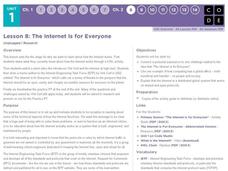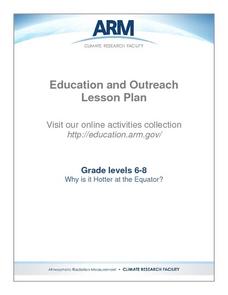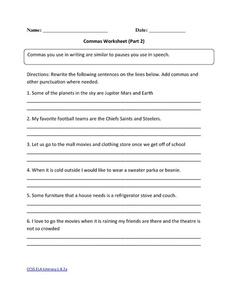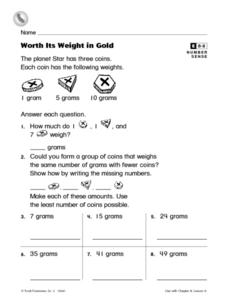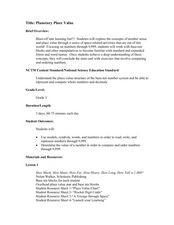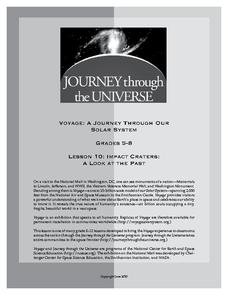University of Colorado
The Moons of Jupiter
Middle schoolers analyze given data on density and diameter of objects in space by graphing the data and then discussing their findings. This ninth installment of a 22-part series emphasizes the Galilean moons as compared to other objects.
University of Colorado
Are All Asteroids' Surfaces the Same Age?
There are more than 600,000 asteroids in our solar system. Pupils analyze images of two asteroids in order to determine if they are the same age. They count craters for each asteroid and compare numbers.
Code.org
The Internet Is for Everyone
What is this thing called the Internet? A KWL activity elicits what the class knows about how the Internet works. Then pupils read a copy of a memo about the need to keep the Internet open and accessible by everyone.
University of Connecticut
Building Your Own Biosphere
On September 26, 1991, four women and four men entered the scientific experiment, Biosphere 2; the doors were sealed for two years in order to study the interactions of a biosphere. In the activity, scholars explore biospheres by...
Curated OER
Negative Numbers Practice Sheet
Fourth and Fifth graders should benefit from this negative and positive number addition worksheet. There are 90 problems to solve; each has a negative number plus a positive number. There are also a few subtraction problems sprinkled in...
Curated OER
Why Is It Hotter At the Equator?
Students investigate the different heating effects of sunlight. They conduct an experiment that demonstrates the way sunlight strikes the equator, the poles and other parts of the globe.
English Linx
Commas Worksheet (Part 2)
Imagine the world if English speakers did not understand that commas are similar to pauses when you speak—it would be a run-on world that is closer to the apocalypse then we would like to admit. Do your part to keep humanity alive, and...
Curated OER
Titan and the Other Moons of Saturn
Students identify and describe the moons of Saturn. They sort the moons by their characteristics. They write a paragraph describing the moons to end the instructional activity.
Curated OER
All About Titan and the Huygens Probe
Students examine the characterisitics of Saturn's largest moon, Titan. They discuss what they think is on Titan and what the Huygens probe can tell them about the moon. They write a summary about the information they gathered during...
Curated OER
The Potential Consequences of Climate Variability and Change
Students analyze the impact of climate variability and change utilizing a broad span of topics over a wide range of grade levels. This three lesson unit is easily adapted for the various instructional levels listed.
Curated OER
Conversation Completions
In this conversation completions worksheet, students choose phrases and sentences to complete communication sentences. Students determine four fill in the blank answers.
Curated OER
Conversation Completions
In this completing responses in conversations worksheet, students read dialogues of two people and fill in the blanks with the correct phrases. Students choose 4 answers.
Curated OER
What Is El Niño?
Students access information at remote sites using telecommunications, identify impacts by reviewing past El Ni??o events, make and use scale drawings, maps, and maps symbols to find locations and describe relationships.
Curated OER
Potential Consequences of Climate Variability and Change
Students examine the potential impact of climate change to agriculture, coastal areas, forests, water, and human health. They hypothesize what might happen to a sugar maple forest and hold a debate about global warming.
Curated OER
Worth Its Weight in Gold
For this comparing weights worksheet, 2nd graders compare and contrast the weight of three different coins and then calculate the answers to eight questions.
Curated OER
Measuring Where We Sit In The Universe
Students investigate scientific measurement. They use a variety of scales to do the job and communicate the results correctly. The teacher uses socratic questioning throughout the lesson checking for comprehension. Students measure some...
Curated OER
Solar System Crossword 2
In this solar system worksheet, students fill in a crossword that gives them clues about the solar system. Students solve 41 clues for the crossword.
Curated OER
Weather / Seasons
Third graders hear and use the terms: el verano, la primavera, el invierno y el oto¿¿o. They review particular months in Spanish. Students explore the difference in connections between months and seasons in northern and southern...
Curated OER
Suited for Space
A fantastic lesson on survival in outer space should excite your learners! Pupils explore the challenges that living, working, and surviving in space elicit. They focus on the spacesuit itself; how it protects astronauts, and enables...
NASA
Biology Training Module
Are you a koalafied biologist? The lesson begins with research about human survival and our ecosystem. Then, an online training module simulates the effects of changes to the plants and animals in an ecosystem. Finally, scholars research...
National Wildlife Federation
Quantifying Land Changes Over Time in Areas of Deforestation and Urbanization
Is qualitative or quantitative research more convincing when it comes to climate change? In the eighth lesson during this 21-part series, scholars begin by performing a quantitative analysis of deforestation and urbanization. Then, they...
Curated OER
Planetary Place Value
Third graders explore place value to the ten thousands place. This incredibly thorough, 24-page lesson has learners construct, order, and compare numbers to 9,999. This three-day lesson includes reteaching and extension activities...
Science 4 Inquiry
Genetics, Genetics, and More Genetics: Exploring Independent Assortment and Non-Mendelian Genetics
Two individuals share 99.9 percent of their genetic codes, yet diversity is observed everywhere. Young scientists learn about diversity through hands-on activities and an experiment. They apply the concepts of independent assortment and...
Journey Through the Universe
Impact Craters: A Look at the Past
The Galle crater on Mars is also known as the Happy Face crater because of its appearance. First, scholars use pebbles and flour to simulate craters and study their properties. They then apply this knowledge to help decipher the history...




